The lanes are narrow, twisting and turning amidst buildings old
and new. Crumbling old structures with intricate workmanship stand side by side
with art deco buildings, and more modern constructions, which follow no
particular style. Autos, bicycles, motorcycles and vans rush past, blowing
their horns as loudly as possible, while cows saunter past peacefully,
completely unaffected by the noise. In the midst of all this chaos, children
play by the side, and women go about their chores, as we explore these by-lanes
of Bikaner, and its beautiful Havelis.
 |
| Facade of one of the Rampuria Havelis |
The Havelis are homes of the rich merchants of Bikaner. Most of
them are from the early days of the 20th century, when Maharaj Ganga
Singh, the then ruler of Bikaner, invited merchants from far and wide to come
and settle here, giving them a variety of incentives to ply their trade. The
biggest incentives were the Havelis themselves, and it is said, that each
Haveli was handed over to the merchants, at the nominal rate of one Anna, and
one coconut!
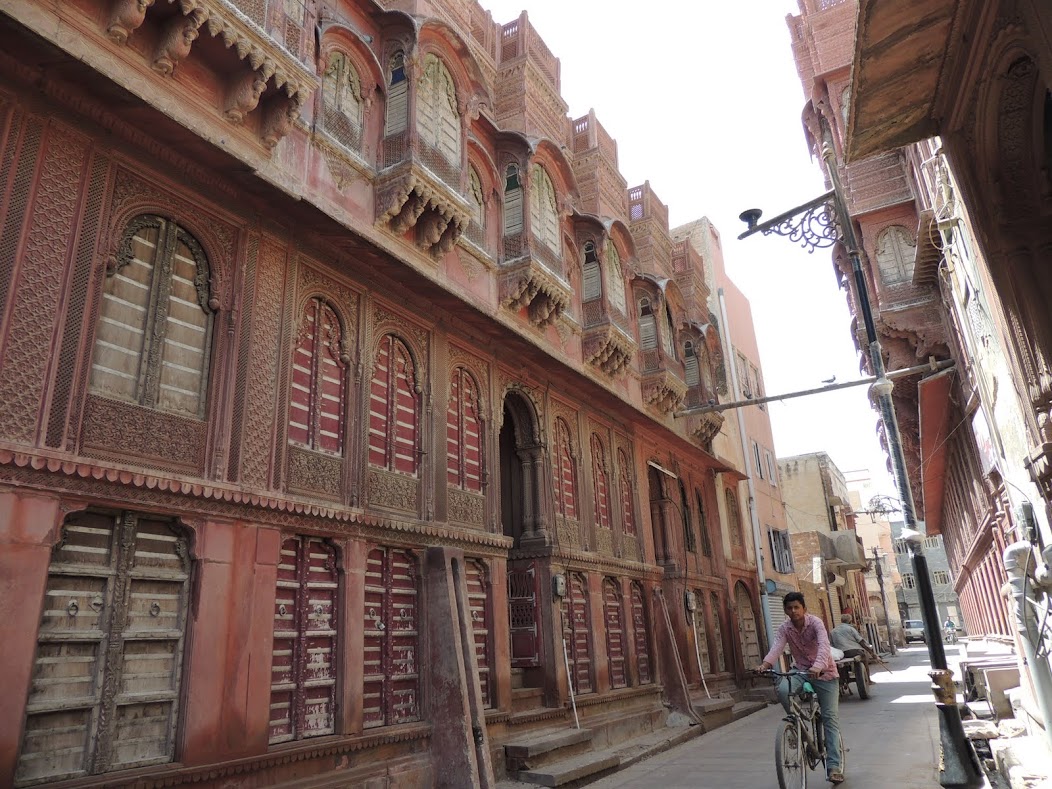 |
| Narrow lanes with Havelis on both sides |
The most popular among all the Havelis are the ones belonging
to the Rampuria families. The Rampuria Havelis are grand structures, their
façades exquisitely ornate. They stand all around one chowk or junction, and
each Haveli belongs to one branch of what must be quite a big family. The first
Haveli we spot is a unique one, with stone faces of British Monarchs glaring
down their noses at us.
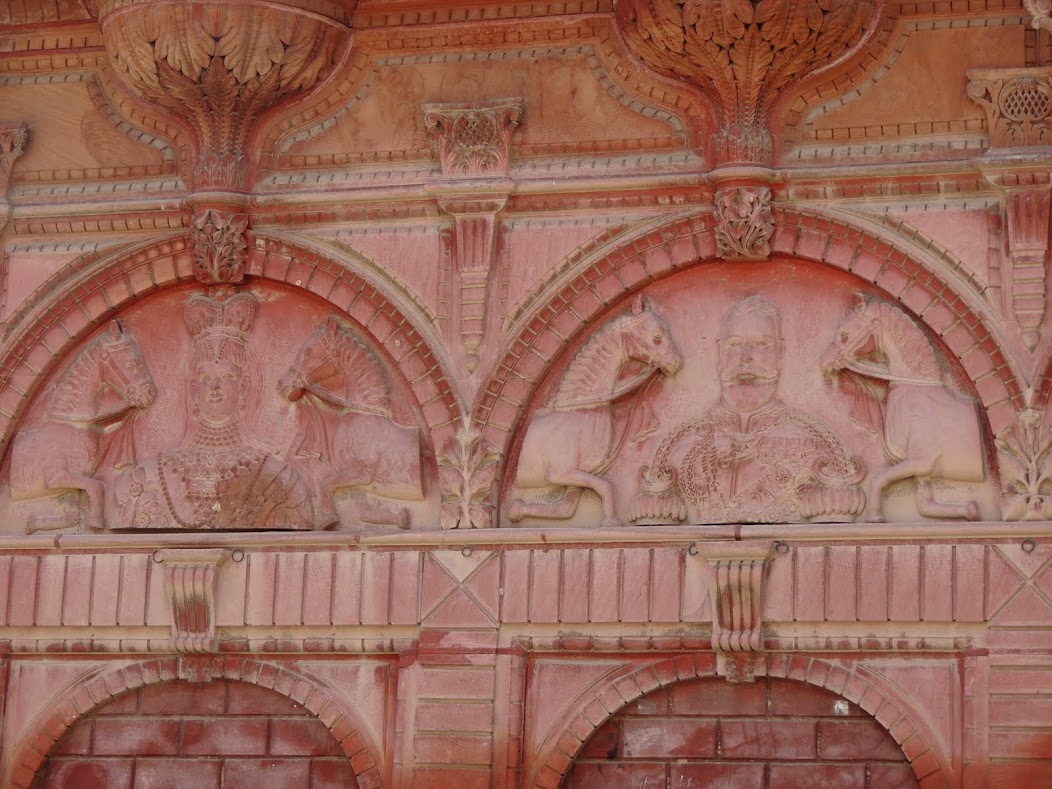 |
| King George and Queen Mary? |
The couple, in all probability, are King George V and Queen
Mary, and they present quite an incongruous sight in this small town. By their
side is another queen, who appears to be an Indian, from the nose ring she
wears, along with the other ornaments.
 |
| An unknown queen |
She could probably be the then Queen of Bikaner, which gives
rise to the question – Why isn’t the king of Bikaner represented here, along
with all these others?
The other Havelis here are bigger, and grander, and tower over
us. However, it is a surprise to see how narrow most of them are, and they seem
to fit into the available space like a piece in a puzzle, and I wonder how they
were first built. Were they intended this way, leaving little space for the
narrow lanes, or did they perhaps replace existing structures, or built
wherever there was space?
 |
| One of the most beautiful havelis |
But it is infinitely more interesting to see the details, than
ruminate over how they were built. Atop one of the biggest Havelis here are
these painted medallions…
 |
| Painted Medallions |
The central one depicts Krishna with Radha, and on the side are
landscapes, which seem to resemble scenes from Europe. All of them seem to have
been copied from prints, which would have been in vogue in the early days of
the 20th century.
 |
| Radha and Krishna |
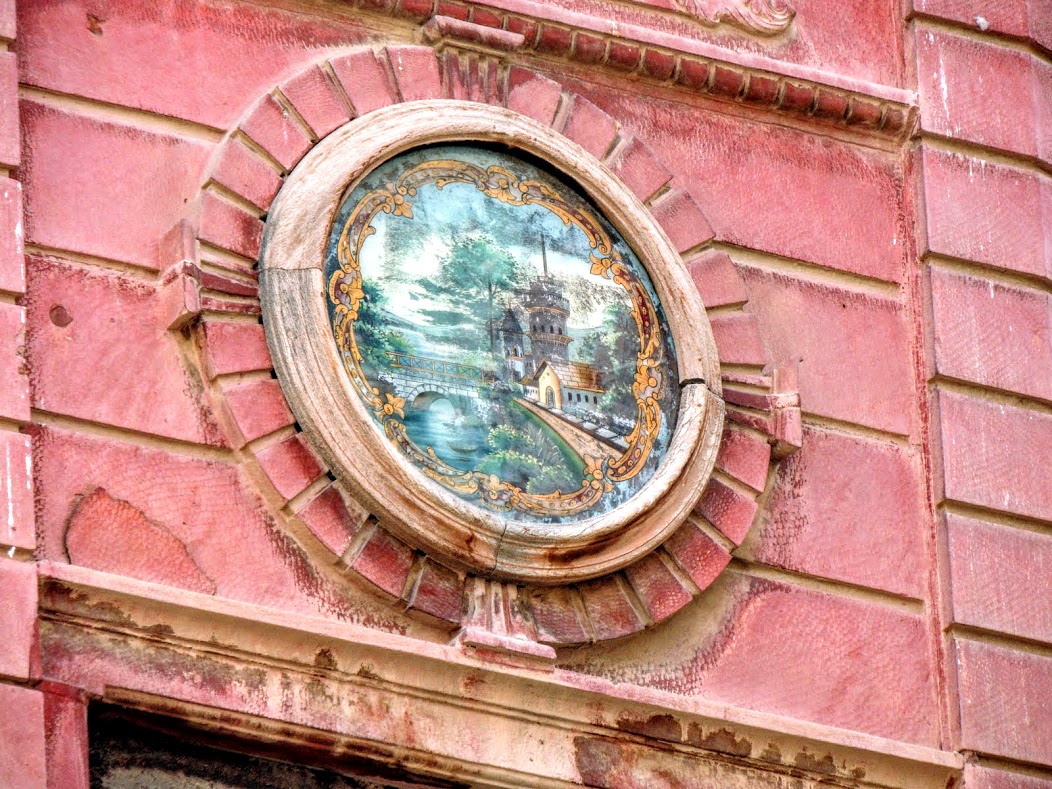 |
| Landscape |
Once, medallions like these would have lined up the entire row
on the second floor of this building. Sadly, only these three remain today!
If the medallions are an indication of western influence, the
doors and the arches are, in sharp contrast, very traditional. They are covered
with ornamentation, and, over the entrances, we can see Ganesha or Gaja Lakshmi. You can even see the name of the owners on some of them.
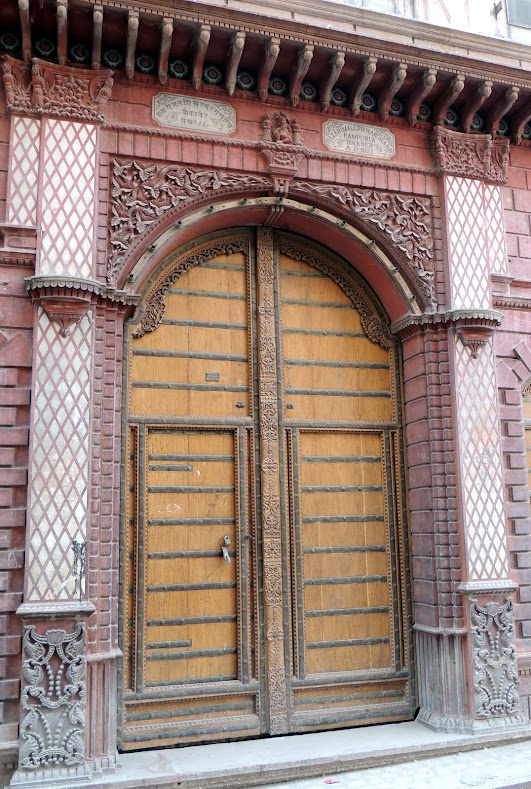 |
| One of the entrances, with the name atop the door |
 |
| Notice the intricate work on the door arch, both in wood and in stone |
 |
| Ganesha with two attendants atop one of the doors |
 |
| Gajalakshmi over one of the doorways |
 |
| Another intricately carved doorway with a beautiful grill |
All these Havelis have a row of doors at the floor level, with
separate entrances for the male and female members of the family. The other
doors lead into small rooms, where the merchants would have sat to transact their
business. The entry to the Haveli itself is at a higher level, and we have to
climb a steep set of stairs to reach the main door.
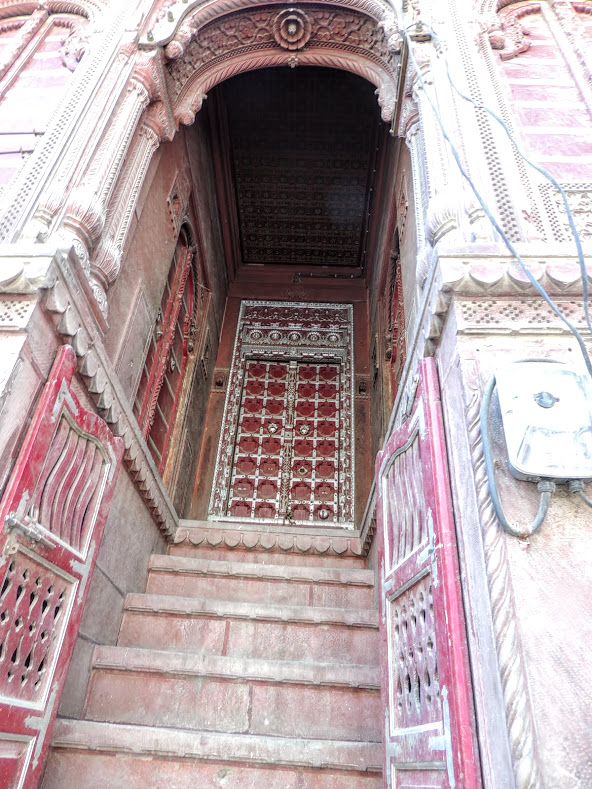 |
| Entry into the Haveli |
These might be the grandest Havelis here, but along these lanes
are so many more, all belonging to rich merchants. A little further away is
another chowk, this one surrounded by the Havelis of the Daddas, another
business family closely aligned to the royal family. They are said to have
helped the king in so many of his ventures, that they were given special
privileges usually reserved for royalty!
 |
| One of the Dadda Havelis |
Riding in a horse cart or
Tonga,
arranged for us by the folks at
Narendra Bhawan, I feel rather regal as we
weave our way in and out of the narrow lanes. Children shout as we pass by,
asking for a ride. Their huge smiles, when we oblige, brighten our day further.
But these are mere distractions, for I have eyes for nothing but the curious
hodge-podge of art which surrounds me.
Art deco buildings stand amidst profusely carved Havelis; there
are structures built over others, extended to accommodate growing families
perhaps.
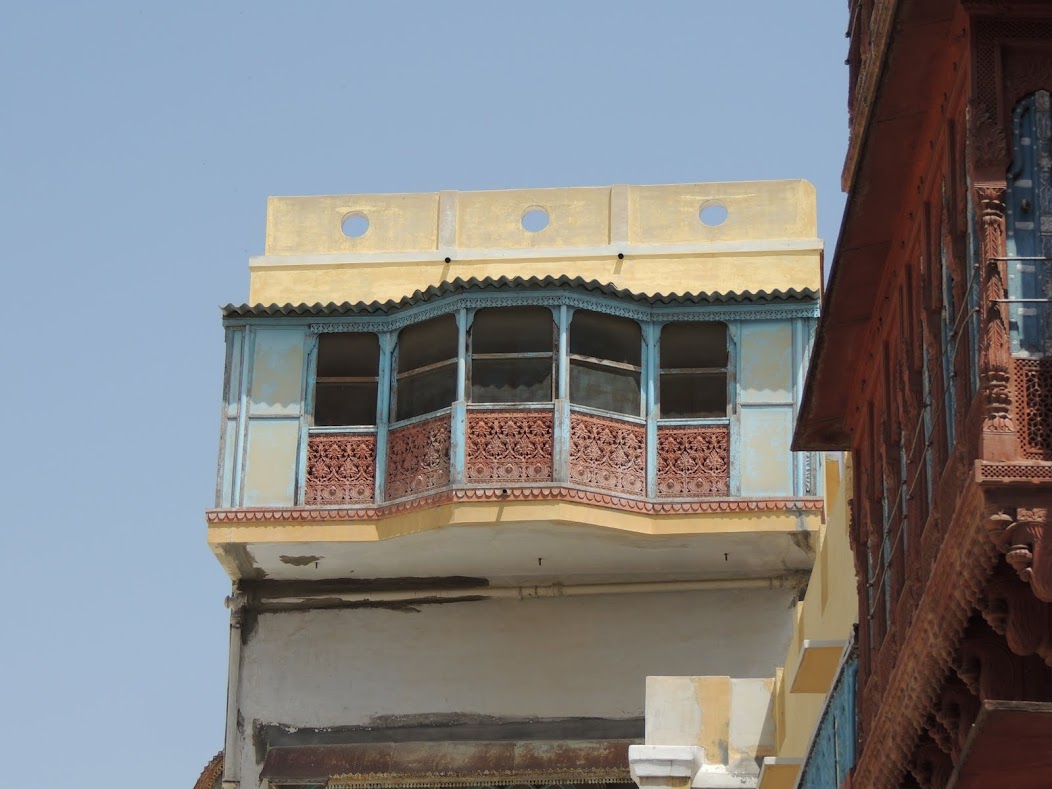 |
| Concrete, stone and plaster.. together |
 |
| One of the Art Deco structures, atop a traditional haveli, with a traditional one on the left and a new one on the right |
 |
| Another Art Deco structure |
But in the midst of it all are gems – like these intricately patterned parapet walls…
 |
| Krishna and the gopis |
 |
| Krishna playing the flute |
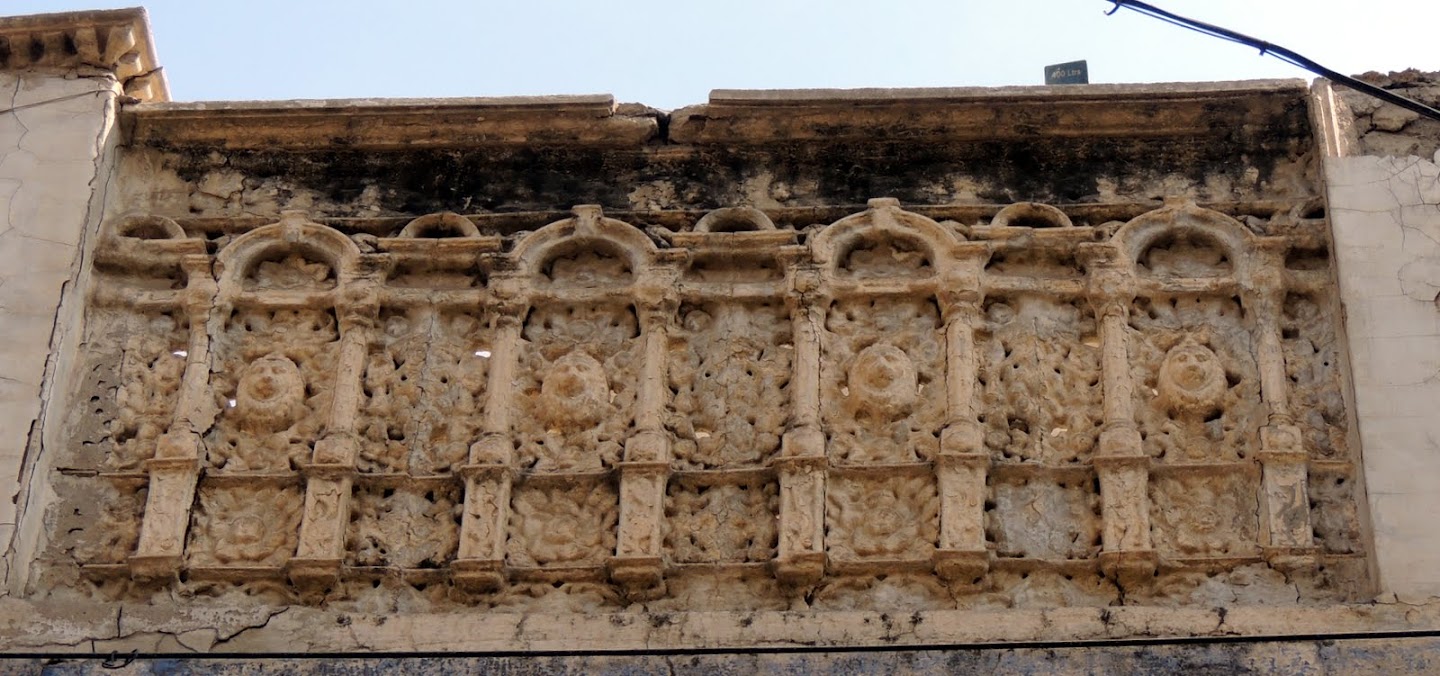 |
| Lion faces |
This gold and silver paper covered shrine, to some form of
Shiva….
 |
| A shrine, decorated with paper... |
A beautiful doorway to a Jain temple…
 |
| Entrance of a Jain temple |
And this big wooden platform, seen at regular intervals. This
is where the men gather every evening, to talk, to discuss…
 |
| One of the wooden platforms |
Decorative tiles seem to have been popular with the owners. The
most common pattern seen is that of a rose…. But there are more interesting ones too, such as these…
 |
| A tile covered wall of a haveli |
Covering the outer wall of one of the more derelict Havelis,
these tiles are patterned with the figures of Lakshmi, Saraswati and Krishna,
based on the paintings of Raja Ravi Varma. Here again is the influence of the
new medium of print!
 |
| A closer look at the tiles. Notice the variety of roses, and Saraswati at the centre |
The same influence is seen inside the Havelis too. The one we
enter has these paintings on the walls of one of the rooms.
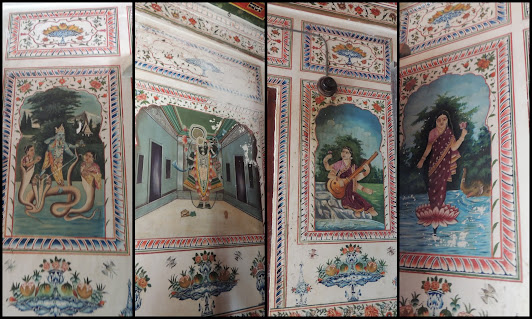 |
| Paintings inside a Haveli.. from left: Krishna defeating Kaliya, Krishna at Nathdwara, Saraswati and Lakshmi |
The rooms of the Haveli are small and intimate, perfect for a
small family. This sounds surprising, till we think of the number of Havelis
belonging to the same family here. These might have been the earliest set-ups
for nuclear families.
 |
| View inside the Haveli |
Settling down for a traditional Jain meal, a thali, it takes us a while to realise
that there is no fan, no air conditioning, and we don’t need it! The small room
is naturally cool, with cross ventilation and its placement taking care of the
air flow.
 |
| The arrangement for lunch |
Completely at ease, after a wonderful meal, I stretch out on
the cushions, look up at the beautiful wooden ceiling….
 |
| The sun, on the wooden ceiling |
…and I can just close my eyes and imagine myself here, with a
book in my hand, a pot of tea by my side. It is a tempting image, one that
makes me want to stay here forever. It is so easy, up here, away from the
clamour of the streets below, to forget the outside world, for a while at
least.
As we finally rouse ourselves, and step back down into the
street, the chaos hits us again, and once more, as we make our way towards our
car, my eyes are drawn upwards – to the brilliant art that surrounds us.
Siddharth points out something I have missed – a painting of a train….
 |
| The train |
The train is painted on the outer wall of one of the smaller
Havelis. It is shown passing on a bridge over a river or canal, between two
stations. The painting indirectly highlights two of the greatest achievements
of Maharaj Ganga Singh – the railways, and the Gang Canal!
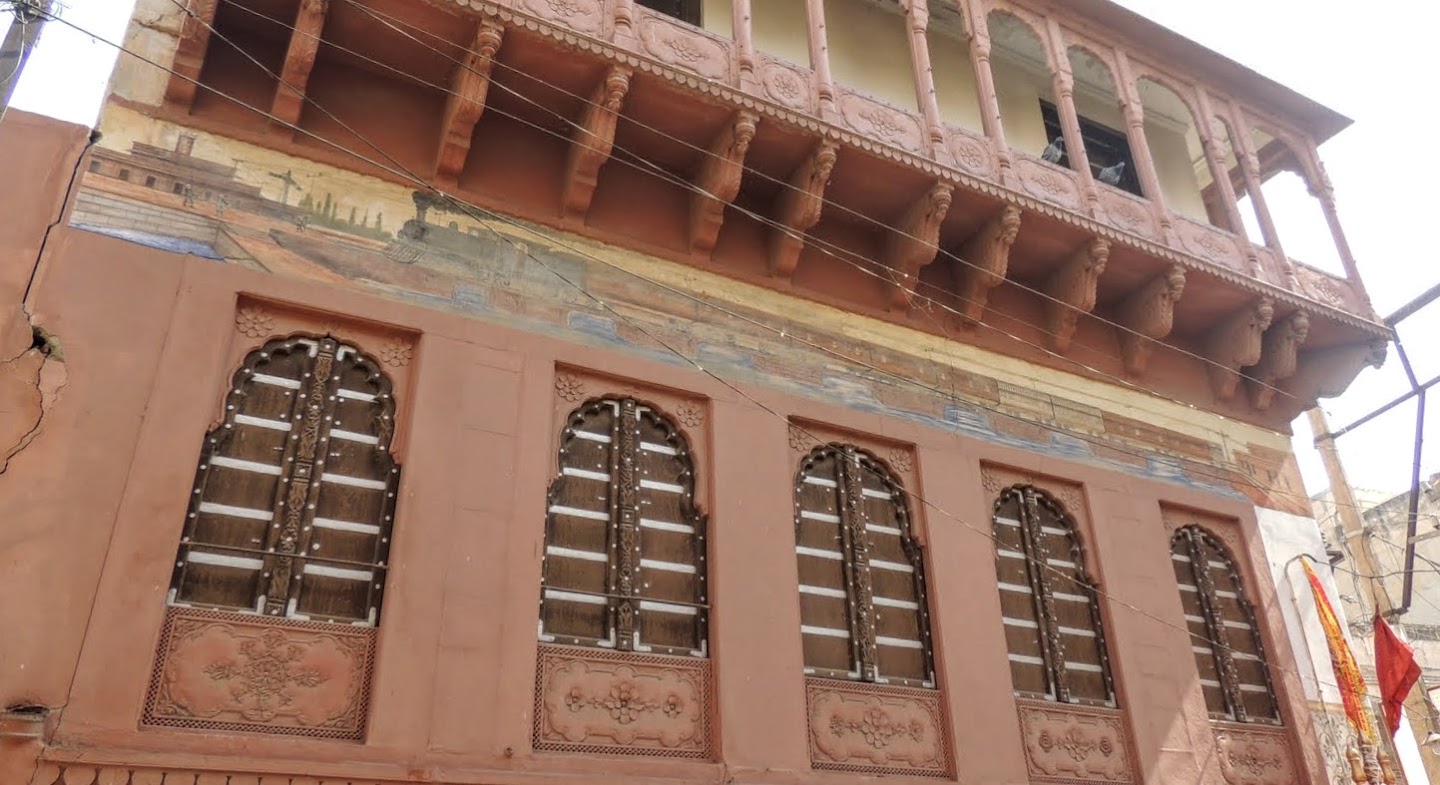 |
| Full view of the train |
It strikes me, as I click the photograph, that the Haveli this
is painted on, itself is an achievement of the king, who managed to bring in
traders and businessmen to Bikaner. As for the Havelis, they themselves are
symbols of the changing times, of new techniques coming in, of the influence of
art from far and wide, of new forms of architecture, yet retaining many aspects
of tradition. Which is what makes them unique!
Disclaimer: I visited the
Havelis of Bikaner with Narendra Bhawan. The ride on a horse cart or Tonga,
followed by the traditional Jain thali in one of the Havelis is part of their
‘Merchant Trail’ experience. The experience is heightened by the conversations
during the ride, the many stories, and the food of course. It is the perfect
way to see these Havelis and experience a different side of Bikaner. While the
experience was courtesy Narendra Bhawan, the words, needless to say, are my
own.
Related Posts:
Fascinating! The carving and tile work are quite something - there were some talented craftspeople who put a lot of effort into their work.
ReplyDeleteI might get run over if I visited since I would probably be standing in the middle of the road for way too long, staring upwards at all the details to be seen! :)
It is fascinating, Natalie. And there is so much more to see! This is just from the outside. So you can imagine how the interiors must be!
DeleteAs for being run over, there are higher chances of you going deaf thanks to the incessant honking that will ensue if you stand in the middle of the road!
Compelling designs and carvings,what kind of patience people had then,love that dining room ,makes me think even today if we could keep our interiors cool without the use of AC
ReplyDeleteAbsolutely, Ani. Their attention to detail is commendable, both when it comes to artistry, as well as practicality.
DeleteLovely frames!
ReplyDeleteThank you Niranjan.
DeleteGreat art and piece of history.!
ReplyDeleteGreat article just keep on posting this.
ReplyDeletevery informative post
ReplyDelete